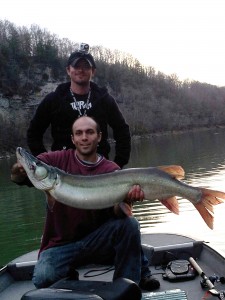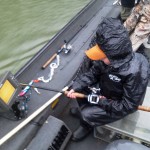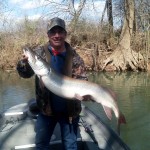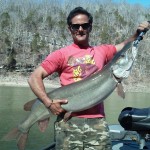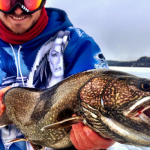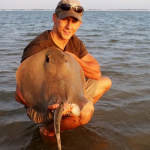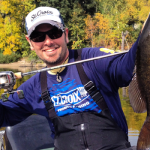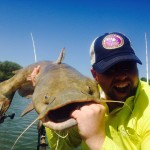By Cory Allen
The concept of versus to begin with, especially in the world of angling where every tactic and tool at our disposal contributes to figuring out the greater rubix cube that is our wonderful little blood pressure spiking past-time, is a bit counter intuitive. I don’t see the two methods of trolling versus casting as exclusive, but mutually beneficial.
I take great pride in my little fishing machine, an early 2000’s Tuffy Ltd…. or as I call it, the “Economesox,” which is decked out with a Terrova 80 lb iPilot and a brand spanking new Yamaha Tiller. I don’t use this type of boat so that I can beat Johnny Triton to the point or outpace the interstate traffic on a causeway crossing the lake, but because it allows a near perfect integration of both casting and trolling and the ability to switch between the two nearly as fast as I decide to switch gears.

Not to brag on my little fiberglass baby, but she hunts like a blood hound running a convict through a Louisiana bayou. From a standing position on the transom, I can run trolling passes quickly and effectively over a point or series of bars working the 12-30 ft breaks and dropoffs. Then I can take 4 giant steps to the front, drop the Terrova, and be able to perform an autopsy of casting on the directly adjacent shallow flat, weedbed, or other skinny water half of the puzzle. That’s seriously something that no fiberglass boat with a 300 hp Verado cannot do with such speed and efficiency. But therein lies the conundrum itself…It seems very few people marry the tactics of casting and trolling in symbiotic rhythm. It seems either they are winging away for hours at a time from the bow, or glued to the transom for the day.
Let me make a bit of a comparison….one that you may or not be able to relate to, but it should clarify somewhat. I remember the days when I was studying to be a professional orchestral musician. We see how well that one worked out. I would run into other brass players that would say “Well, I’m a CLASSICAL trumpet player; I’m a JAZZ trombone player…yada yada yada”. I always found this amusing…music is music is music. It was always amusing to hear a CLASSICAL trumpet player audition on “American in Paris” or another more stylistically jazz influenced piece of “classical” literature, and it sounded like Mary Ford and Les Paul trying to cover Earth Wind and Fire……in the same vein, a JAZZ brass player on Mahler often lacked the chutzpah to drive those ridiculously powerful passages home. The best players in both arenas though, were the ones that treated music as music, no matter what style, flavor, or texture, and could freely move through the membrane of either with ease in their studies.
Let’s convert this to fishing. I look at any body of water and any species, in this case muskies, as a piece of repertoire. Each has a unique environment that demands a unique approach, seasonally, daily, and moment to moment. There are times that people say there is a “trolling bite” or a “casting bite.” I say, the tactic is ancillary to the topography one is fishing.
Let’s set the stage for this one. Last year I had a fly client for musky, but while our goal was to hook up on the pixie stick, he was not opposed to trying other methods as the conditions demanded, which is always my favorite kind of client. As stated before, fly fishing, casting, trolling, and jigging are not mutually exclusive schools of thought, but mutually beneficial approaches to the whole sphere of angling knowledge and execution. They can each do things that the others cannot, and thus complement each other more than define themselves. The objective here is to catch fish, not revel in how you did.
Unless you’re using TNT or a telephone crank, it’s pretty much open season, which in my honest opinion is the beauty of our sport. We had run up a known producing creek arm and he chucked fluff while I side armed Mantas. This was perfect fly water for him but no luck. So we went down to another area after a which load and tow, an area that had actually produced a nice fish for a fly fishing client of mine just a few days prior, and resulted in a shredded 80 lb fluorocarbon leader by a truth leviathan.
The dark water and current in the main channel usually results in very shallow holding muskies, some just out of sight in the 6” visibility conditions. On this day however, we were dealing with post frontal conditions and fish were absolutely hung over from it, despite the offsetting effects of darker water and current. He casted fly like a champ in blistering wind and piped the ace on some excellent g-spots that had been producing well on mid-40s in 1-3 feet of water. At the same time I was launching my surface-to-sea missiles as well, but alas nothing. John Kohl was out for his first fish though, and thankfully open to suggestions.
The flat we were fishing was directly related to several clandestine points not tipped off by the shape of the shoreline. They all broke great depths, and led to the deepest water in the area. This is why the flat itself was such a fish factory. I instructed him to pack up the fly rod and we were going to troll. At first, he looked at me cockeyed, and figured “Oh joy, let’s play that exciting new game show ‘Hold the rod for 6 hours while we putt-putt in circles.” As I went into further detail about the situation we were dealing with, and the advantageous nature of trolling in this particular situation, you could see the light bulb start to come on. When I ended my little address with the statement “Trolling is simply being able to make a cast of infinite length, depth, and speed control within the confines of reason,” it clicked and John was totally on board.
Most of my trolling passes don’t extend farther than the existence of the topography we’re fishing, anywhere from 20 yards to a 100 yards. But anything past that is rare for me as most of the areas I fish do not have extended running breaklines. Therefore they do not demand extended trolling passes, but rather the ability to keep a lure down, bump and grind the length of the structure, and turn around to do in 45 seconds. In comparison to casting, this would take 4-5 hours to cover effectively. In this situation, trolling was absolutely invaluable.
Literally on the 3rd turn around, as my trolling passes got progressively cleaner and tighter to the break, something nearly grabbed the rod from his grip in the blistering cold. If you’re not holding the rod while you’re trolling, you’re not only missing out on some absolutely epic strikes, but you’ll be missing a lot of details in bump-and-grind trolling that you’d miss while leaving the rod in a holder. Ten minutes later, we were posing with a healthy happy livewell revived 48” Tennessee tanker.

Yes, John is coming back when the conditions are more conducive to using the fly, and we’ll get them for sure. But in this case, being dogmatically stubborn to casting fly or conventionally would have most assuredly cost us this fish holding on a break just out of current dropping from 15 ft into 24 ft. With the depth of that particular feature combined with the current, trying to effectively fish it while casting would have not only been difficult, but it may have been downright impossible to get that fish to react otherwise.
Okay, just to make sure this isn’t a love letter to motor trolling, let’s take a gander at another switch. Often times even after the lake draws down in winter, the nature of our riverine reservoir and being at the footsteps of a plateau means an inch of rain goes a mile, and things fill up fast. Both casting and trolling conditions exist during most of the colder part of the year, but when the main channel fills to the brim, conditions exist in small pockets and coves out of the main channel current that draw in large numbers of large fish if you know what to look for. Trolling the main lake drops and breaks is simply not the smartest thing to do. But in these chocolate milk-like conditions, these relatively shallow but sequestered spots are where the fish move to meet the demands of their highly efficiently tuned biochemistry. These areas are much too short, often too shallow, and too close quarters to really consider trolling in many cases. Casting is the ticket for sure. Sadly as soon as these areas fill up in winter, the clock is already ticking, as the TVA does its best to empty the lake as quickly, as or faster than it fills. We hit them hard and we hit them fast while the gettin’s good. But if I were to be a strict “troller” I would completely miss this opportunity.
Last spring, we dialed in and after losing several low to mid 40” fish in this one pocket less than 2 acres, we brought to boat a 49.5” fish that touched the 40 lb mark. Another fantastic testament to the quality of the fish these Tennessee waters can produce, and even more amazingly mostly from natural reproduction as well as the fruits of being adaptive and versatile to the momentary conditions, and letting the arena dictate the weapons of war.
Something that being in such a weird diverse little musky habitat as middle and Eastern Tennessee has taught me, where the line between reservoir and river is so often blurred, and a rather low density but high quality fishery is that myself and fellow guides, Nick Adams, and Jase Bouldin can’t afford to waste time being loyal to a tactic simply out of our personal preference. Nick is an absolute topwater savant, and has shown me that the tactic is much more applicable than I ever thought, especially during the daylight hours and over deeper water than I imagined. Jase has shown me the value of using kayaks in shallow water haunts otherwise not only impassable by boat, but the intrinsic intrusiveness of an internal combustion driven vessel drastically reduces your chances of successful interaction in these very intimate environments. Myself? I get off to topography and nothing gets me riled like a line of markers on a bar and pulling a musky bottom bouncing off a spot I intuitively mark as a high potential fish holding spot, just as the fish that John Kohl brought to the net that day. That kind of validation is just short of crack to me, but then again I’m not in this for my personal preferences. I’m in this to learn, perpetually, grow, and interact with some amazing animals that otherwise I’d probably never see let alone actually watch do what they do best…kill things…if I didn’t fish.
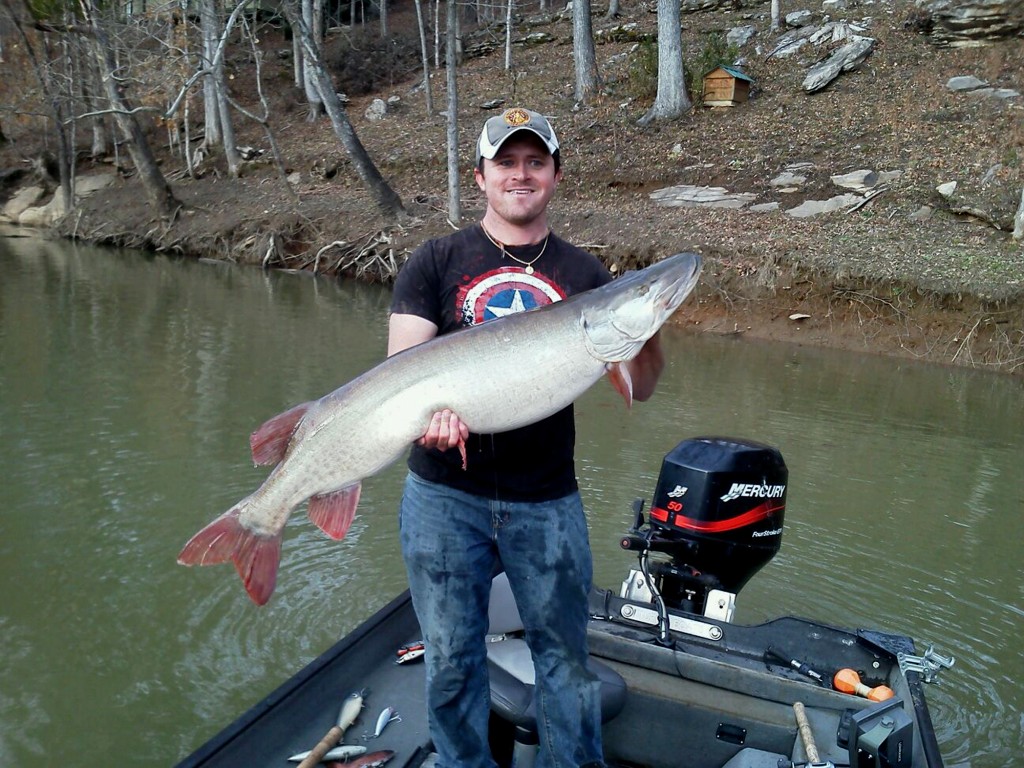
While the musky nuts at the Stone’s Throw Adventures, Nick Adams, Bryan Morris, Jase Bouldin and myself all have our fan favorites, we have learned to share our strengths and confront our weaknesses together. Through real time communication and dropping the ever destructive ego, we continually synthesize ourselves into more efficient and effective anglers and guides. That’s why I’m in this sport, and that passion and pursuit defines whatever means necessary within the confines of sportsmanship that I choose to use on a given day or water or species.
Cory Allen, 27, of Cookeville, Tennessee is the founder and lead guide of Stone’s Throw Adventures. Allen’s team of guides fish the waters throughout Tennessee and Kentucky, guiding on a year-round basis, and offer their clients a wide variety of boat and wading trips for all species of gamefish. http://www.stonesthrowadventures.com/



